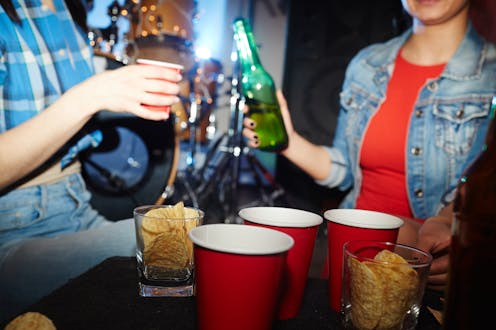Alcohol is becoming more common in sexual assault among college students
- Written by Mary P. Koss, Regents' Professor of Public Health, University of Arizona

The Research Brief[1] is a short take about interesting academic work.
The big idea
One out of every three. That is the number of women in college who say they have been a victim of sexual assault either when they were in high school or college. That’s according to my new peer-reviewed research[2] in the Journal of Interpersonal Violence, which is based on survey data from 2015.
That figure is significantly higher than it was in the mid-1980s when I conducted the first such national survey of college students[3] at 32 institutions. Back then, the number was one out of every four.
Of these incidents, 75% involved victims who admitted they were incapacitated by alcohol at the time of the assault. In the mid-1980s, that number stood at 50%.
For the study, sexual assault was defined consistently with the federal definition of rape[4]. That definition goes beyond forcible rape. It includes oral, anal or vaginal penetration when the victim is too intoxicated to consent.
Among college men, one in 19 admitted during the first survey to having committed sexual assault while in high school or college. That number has increased to one one of every eight.
One thing that hasn’t changed is that the vast majority of college men who responded to the survey and admitted to committing sexual assault, say they perpetrated the sexual assault while their victims were incapacitated by alcohol. Then and now, that figure has stood at approximately nine out every 10 college men who admitted to sexual assault. That means the most common scenario[5] for sexual assault of women in college involves men who take advantage of women when they are incapacitated.
For the first survey, conducted in 1985, 6,159 students responded to the questions. For the second survey, which I conducted in 2015 and have been analyzing over the past several years, 2,471 students responded. Both surveys got response rates of more than 90%.
Why it matters
These findings matter because colleges have been trying to implement programs and strategies to reduce irresponsible drinking and the role it plays in sexual assault. If the prevalence of rape is going up instead of down, it calls the effectiveness of these programs into question.
Prior research – including by the Centers for Disease Control and Prevention[6] in Atlanta – has already established that these approaches to alcohol abuse prevention and associated sexual harm have been largely ineffective[7]. That is to say, they neither reduce problematic drinking nor dissuade perpetrators from taking advantage of victims when they are incapacitated.
What’s next
Researchers have suggested a need to take a closer look[8] at trying a more comprehensive approach to preventing sexual violence. This includes modifying drinking environments[9].
Changing the drinking environment could entail efforts to change or regulate practices at the bars and liquor stores on or near college campuses, such as “2-for-1” drink specials, beer in pitchers, “ladies nights” in which women pay less than men for alcohol or cover charges, and sponsored drinking games, such as beer pong or flip cup.
References
- ^ Research Brief (theconversation.com)
- ^ peer-reviewed research (doi.org)
- ^ survey of college students (www.ojp.gov)
- ^ federal definition of rape (www.justice.gov)
- ^ most common scenario (www.ojp.gov)
- ^ by the Centers for Disease Control and Prevention (doi.org)
- ^ have been largely ineffective (doi.org)
- ^ take a closer look (doi.org)
- ^ modifying drinking environments (doi.org)
Authors: Mary P. Koss, Regents' Professor of Public Health, University of Arizona

